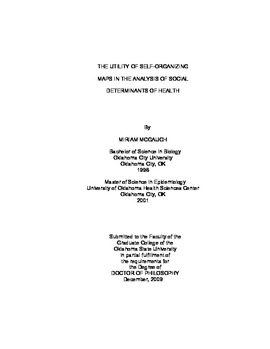| dc.contributor.advisor | Miller, Janice | |
| dc.contributor.author | McGaugh, Miriam | |
| dc.date.accessioned | 2013-11-26T08:34:43Z | |
| dc.date.available | 2013-11-26T08:34:43Z | |
| dc.date.issued | 2009-12 | |
| dc.identifier.uri | https://hdl.handle.net/11244/7504 | |
| dc.description.abstract | Scope and Method of Study: The purpose of this study was to present a method for analyzing existing, nationally-available social data in a health context. This research study utilized the Public Health Model of the Social Determinants of Health (PHM) as a theoretical guide for selecting variables from existing, archival data sources to represent social determinants, health behaviors, and the health outcomes within Oklahoma at the county level, which was the unit of analysis. Additionally, this study introduced the Self-Organizing Map algorithm as an alternative data reduction technique for analysis of health and social data. The study further analyzed which of these sets of health variables were stronger predictors of the health outcome, age-adjusted mortality rate. Three phases of research were conducted: self-organizing map analyses to determine the underlying mathematical structures of social determinants of health variables and health behavior variables, a multiple regression analysis on the two resulting SOM solutions for determination of the stronger predictor set, and correlation analysis among the SOM variables and the health outcome to determine construct development. | |
| dc.description.abstract | Findings and Conclusions: The overall results support the use of the Self-Organizing Map algorithm in the analysis of public health data. The SOM analysis of social determinants of health variables revealed four clusters: Mid-Century Service-Oriented Communities, Struggling Minority Communities, High Income and High Education, and Long-term Farmland. The health behavior SOM analysis identified six clusters: Restricted, Health Promoting, Overweight and Obese, Conflicted Intimate Partner Violence, Conflicted Mental and Physical Health, and Safety Not Health-Related. The multiple regression analysis resulted in a significant model with two significant parameters: Mid-Century Service-Oriented Communities and Struggling Minority Communities. Correlation analysis identified a cohesive construct for the social determinants of health SOM variables, but a less coherent health behavior SOM construct. Further research is needed to define this area better and extend these findings. | |
| dc.format | application/pdf | |
| dc.language | en_US | |
| dc.rights | Copyright is held by the author who has granted the Oklahoma State University Library the non-exclusive right to share this material in its institutional repository. Contact Digital Library Services at lib-dls@okstate.edu or 405-744-9161 for the permission policy on the use, reproduction or distribution of this material. | |
| dc.title | Utility of self-organizing maps in the analysis of social determinants of health | |
| dc.contributor.committeeMember | Perry, Katye | |
| dc.contributor.committeeMember | Montegomery, Diane | |
| dc.contributor.committeeMember | Hughes, Patricia | |
| osu.filename | McGaugh_okstate_0664D_10613.pdf | |
| osu.accesstype | Open Access | |
| dc.type.genre | Dissertation | |
| dc.type.material | Text | |
| dc.subject.keywords | community epidemiology | |
| dc.subject.keywords | kohonen | |
| dc.subject.keywords | public health model | |
| dc.subject.keywords | self-organizing map | |
| dc.subject.keywords | social determinants of health | |
| dc.subject.keywords | social | |
| thesis.degree.discipline | Educational Psychology | |
| thesis.degree.grantor | Oklahoma State University | |
